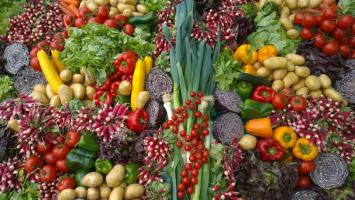
DIET & LIFESTYLE
DISCOVER HOW TO HEAL
Written by John Immel, But what if you were aware of how your body reacts to food? You would be able to select foods that make you feel good. One of Ayurveda's greatest gifts is body awareness. It's simple to learn. Ayurveda focuses on your body's experience and reactions to foods rather than biochemical reactions, which is Western medicine's approach. Ayurveda shows you how your body naturally relates to food, disease, and the environment. Think about the last time your family went out for Mexican food and you ate too many jalapenos. You may have felt "hot under the collar." What you were feeling was the medicinal effect of the jalapeno. An Ayurveda practitioner knows how to use this effect to help someone heal. Every food you eat has an effect on your body, your emotions, and your thoughts. By developing the art of noticing these feelings, you are able to intuitively discern the effect foods have on you without memorizing charts. As a result, you are able to personalize Ayurveda. What to Notice"Felt sensing" is the art of feeling what is happening in your body. At first it is difficult to feel what is happening; you may have a vague sense of how a food affects you, or whether or not you like it. Even if you are able to feel what is going on, translating those feelings into words may be a challenge. The feeling may be difficult to describe.Fortunately, Ayurveda has a technique to build this awareness and to help you figure out the impact of food on your body. Start by noticing where you have physical sensations. If you don't feel anything, check your head, heart, gut, and skin. Then, notice the type of sensation.
Biocharacteristics
Finally, feelings may be hard to talk about, hard to describe. Use biocharacteristics (gunas) to help you fully articulate & grasp the feeling, and therefore the effects of the food you've eaten. This is simpler than it sounds - just try it! Is the feeling heavy or light, hot or cold, oily or dry? For example, chilis create a hot experience while cucumbers create a cool one. Bread feels heavy while salads are light and refreshing. Butter is oily and smooth while popcorn is dry and rough. Black pepper is sharp while the experience of cheese is dull.
Once you figure out which biocharacteristics are involved, you'll find the impact of food is easier to perceive. It will be much simpler to understand what you're feeling and talk about it. And, it will be much simpler to restore balance. Once you have translated your experiences into these biocharacteristics, Ayurveda also shows you the biocharacteristics and foods that can help you feel better. Translating feelings into biocharacteristics is the fundamental skill Ayurveda practitioners use to heal their clients. Now, you can use it too, and can easily pinpoint how each food impacts your dosha (constitution). To figure out a new ingredient, eat it every day for a week, in various cooking preparations. Systematically go through the guidelines of analysis laid out above. Take note of your physical and emotional experiences throughout the day and as you eat the ingredient. An easy way to improve your awareness is by comparing your experience to other foods. By consistently developing this level of awareness, you will gradually gain an intuitive understanding of the ingredient. Over time, the art of felt sensing will become automatic. This level of connection with your body's experience of food will empower you to make healthy eating choices with ease. When to Notice
Checking Your FactsAfter you've completed these steps, it's time to check your facts. Look at references like the Joyful Belly website or other Ayurvedic texts to see if there's something you've missed. Ultimately, trust your body over the textbooks. Only you know your relationship to cilantro or apples.The art of felt sensing is easy to learn, but it takes practice. Repetition and mindfulness are essential to developing this skill. Each time you practice it, you'll have little "aha!" moments that are not only exciting, but insightful and meaningful. Through this method, you'll be learning how to take care of your unique body. Journal your discoveries as you go. Your relationship to food is not a static thing, but an ever-changing dynamic requiring moment to moment awareness. For example, sometimes the impact of food changes seasonally. I've found that beans taste astringent and unappetizing in the fall when they would likely aggravate Vata, but sweet and delicious in the spring when they will likely pacify Kapha. Let Ayurveda guide you in developing that level of awareness until it becomes second nature. When it comes to well-being, there is no better investment of time and attention than getting to know the subtleties of your body. READ MORE ON THIS TOPIC
BROWSE SIMILAR ARTICLES BY TOPICSKIN-CAREIncludes skin care, and anything that nourishes epithelial membranes (of digestive, respiratory, urinary tract, blood vessels, etc).

About the Author John Immel, the founder of Joyful Belly, teaches people how to have a healthy diet and lifestyle with Ayurveda biocharacteristics. His approach to Ayurveda is clinical, yet exudes an ease which many find enjoyable and insightful. John also directs Joyful Belly's School of Ayurveda, offering professional clinical training in Ayurveda for over 15 years.John's interest in Ayurveda and specialization in digestive tract pathology was inspired by a complex digestive disorder acquired from years of international travel, as well as public service work in South Asia. John's commitment to the detailed study of digestive disorders reflects his zeal to get down to the roots of the problem. His hope and belief in the capacity of each & every client to improve their quality of life is nothing short of a personal passion. John's creativity in the kitchen and delight in cooking for others comes from his family oriented upbringing. In addition to his certification in Ayurveda, John holds a bachelor's degree in mathematics from Harvard University. John enjoys sharing Ayurveda within the context of his Catholic roots, and finds Ayurveda gives him an opportunity to participate in the healing mission of the Church. Jesus expressed God's love by feeding and healing the sick. That kindness is the fundamental ministry of Ayurveda as well. Outside of work, John enjoys spending time with his wife and 7 kids, and pursuing his love of theology, philosophy, and language. STUDY AYURVEDA
Questions, Comments & Impressions of 'improving your body awareness of food'?Is there something else you'd like to know about 'improving your body awareness of food'?     (5.00 out of 5 stars) 1 rating, 195 likes (5.00 out of 5 stars) 1 rating, 195 likes     Sign in to review this article Sign in to review this article
We do teach more about this in our 500hr certification program, and through some of the articles on our website. Thanks for asking and I'm glad you "experienced" the article via Yerba Mate...
|
Join Joyful Belly.
Want our top Ayurvedic recipes and health tips?Subscribe to our free newsletter!

 SAVE ARTICLE
SAVE ARTICLE

 On MeWe
On MeWe On Pinterest
On Pinterest On Facebook
On Facebook On Twitter
On Twitter On WhatsApp
On WhatsApp On Email
On Email


